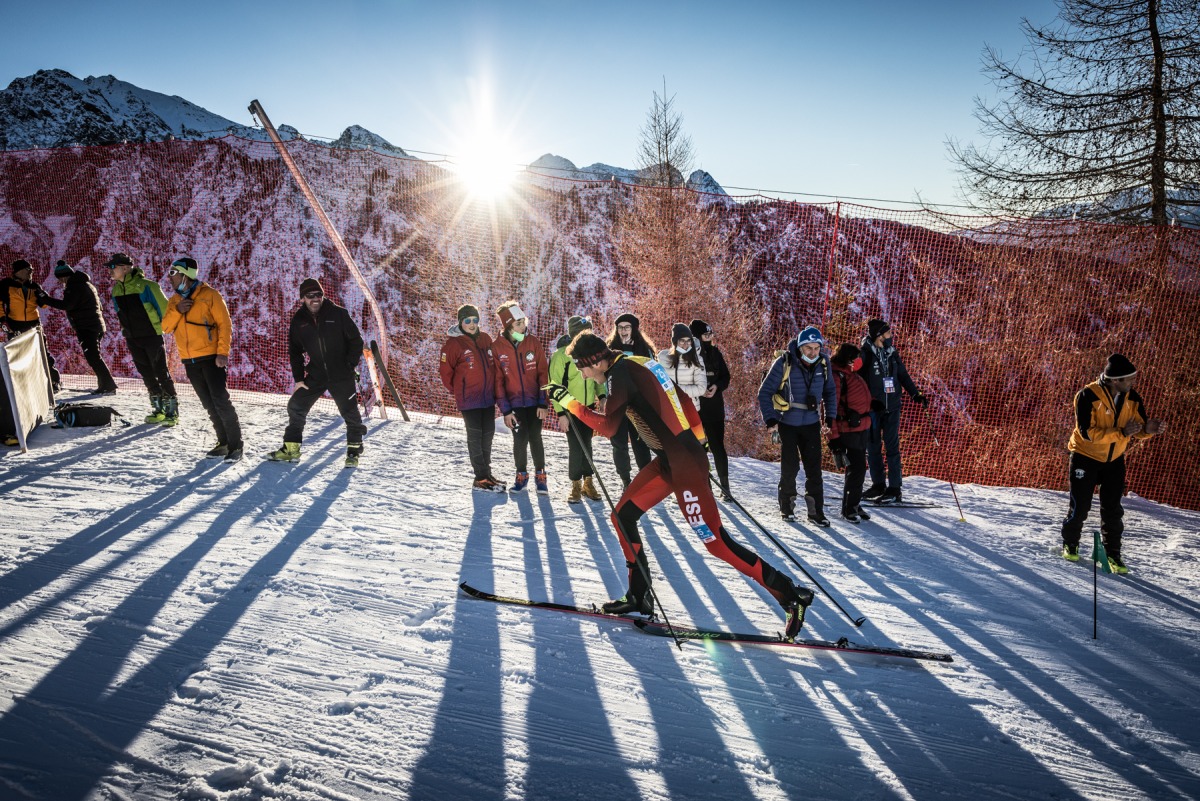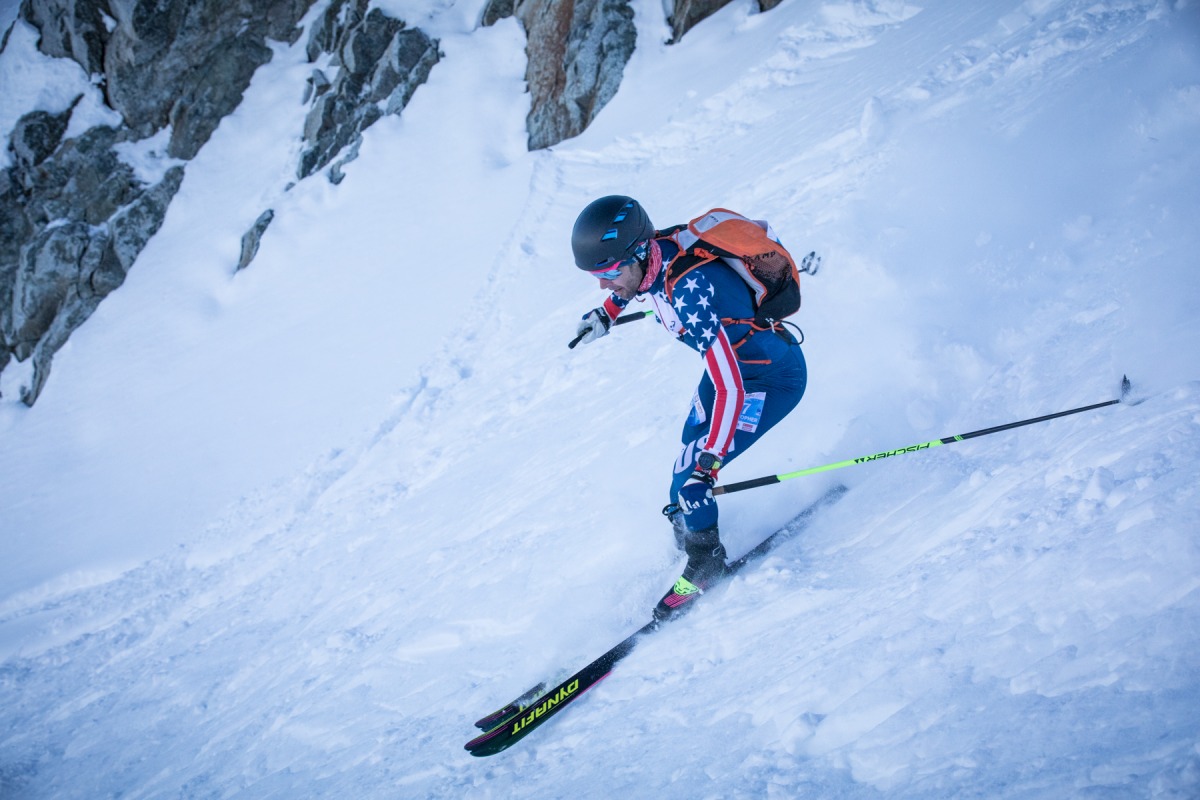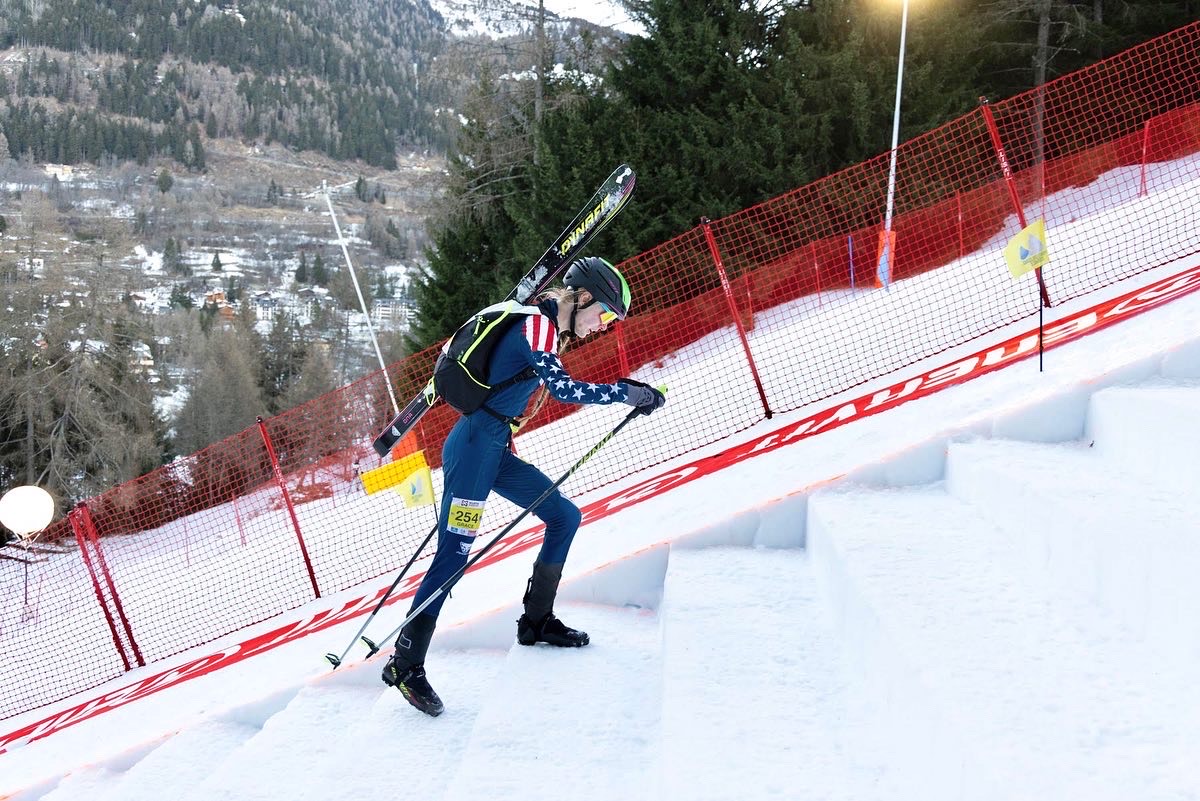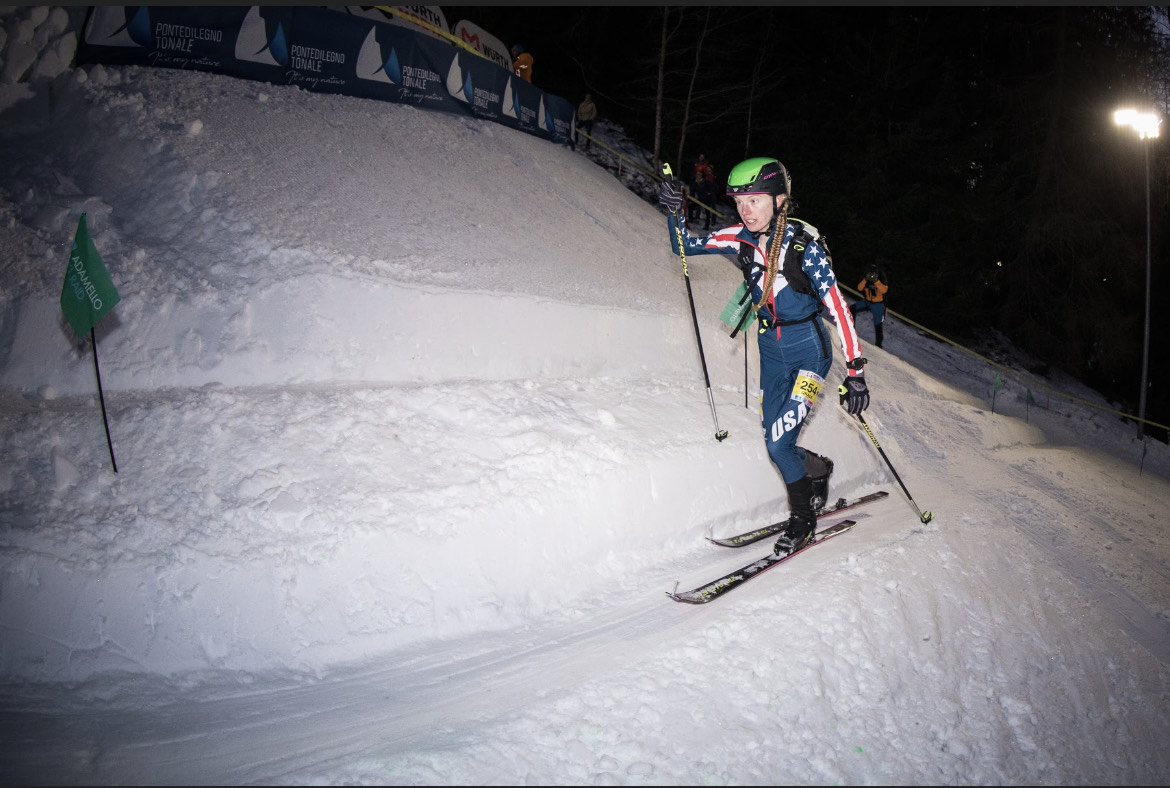
Grace Staberg finding her way during the semi-final round at the Adamello World Cup Sprint. Photo: Maurizio Torri.
I’m standing outside the Hotel Mirella in Ponte di Legno, Italy watching my coach, Laetitia Roux, say goodbye to the last of the ISMF race officials, photographers, and friends we’ve spent the weekend with at the first ISMF Skimo World Cup of the season. For five days, racers from different nations raced Sprint, Vertical, and Individual format races. The first skimo World Cups begin a long season; seven World Cup races, multiple Grande Course races, the Long Distance Teams World Championships race, European Championships, National Championships, and a whole host of more minor, regional events that racers have come to love.
For the weekend, the small town of Ponte di Legno, Italy, was overtaken by the Lycra-clad. While spectating a World Cup race, expect to see plenty of full carbon boots and the newest tech on people spectating and skiing with friends. The “light and fast” culture is alive and well in Europe.
I remember coming to my first World Cup weekend in December of 2019, immensely curious about what I had signed up for. Over time, I’ve become grateful that what we’re signing ourselves up for is often a well-organized race weekend that allows us to focus on performance as racers. Teams stay in various hotels booked through the ISMF (our governing body) and the local organizing committees. Our meals are provided for each day, and more often than not, the start is easily accessible from the hotels. We can focus on the goals of the weekend, get our shakeout ski sessions completed, and spend time with friends we’ve missed during the summer hiatus from skimo racing.
I often find myself marveling at the scene of the World Cups. The spectators are lining courses to cheer, and some of the best skiers toe the line. This weekend, for example, in Adamello, men hit speeds over 100km/hr while skiing off-piste, on set-ups totaling less than 800 grams. Considering descending ability, the Europeans are in a league of their own.
The racing is paramount, but there’s still plenty of time to enjoy local culture and opportunities to take in the views. Take this weekend: at the flower ceremony atop the Vertical course on Friday, we get to be spectators for one of the best sunsets of the year, and our Individual course reconnaissance on Saturday was perfected by sun, panoramic views, and delicious Italian chocolate, thanks to our third American teammate, Christopher Jones.
Our time in Ponte di Legno was the usual World Cup routine; eating, skiing, sleeping and repeating. But as with the beginning of every new season, there were a few changes. Without at least one mention of the rules and regulations, it wouldn’t be a proper explanation of the World Cup Circuit; there are enough to fill multiple books. The most notable for the 2021/2022 season? The introduction of mandatory ski brakes, which left many athletes scrambling in the pre-season, was implemented at the first World Cup with fewer hurdles than expected.
One significant addition for 2021 is an ISMF World Cup livestream. This feed makes it possible for American fans to watch the full complement of racing from home (and for me to watch from my bed at the hotel when the youth sprint races end hours before the senior sprint races). With the news of the Olympic inclusion in Italy 2026, I expect our sport to become more popular (by a modest amount). The ability to broadcast races to a larger audience is a massive step to familiarize people with the sport and capture a dedicated audience.
With the complications of COVID, I hope the livestream also provides families the opportunity to watch remotely. As for us racers, we create a “bubble” of sorts at each World Cup, with all participants required to present a negative test upon arrival while unvaccinated racers/coaches are tested every 48 hours while at the venue. Plenty of masks and sanitizer dispensers are available – the scene generally feels respectful of COVID regulations. I’m sure I’m not the only one grateful that both our 2020/2021 and 2021/2022 seasons have been able to proceed as planned.
As usual, the French, Swiss and Italian teams filled most of the start line spots in Ponte di Legno (and most of the podium spots) though the smaller nations put on a good showing. Austria’s Paul Verbnjak won his first Individual Race in the U23 category. Sweden’s Tove Alexandersson had a great weekend coming 2nd in the Senior Women’s Individual and Vertical races, and Norway’s Hans-Inge Klette placed 2nd in the Senior Men’s Sprint race. In Thursday’s Sprint Race, we got to enjoy a lively night of racing under the lights, and Sunday’s Individual Race brought sunny, snowy conditions up high. The weekend was a beautiful start to the year.
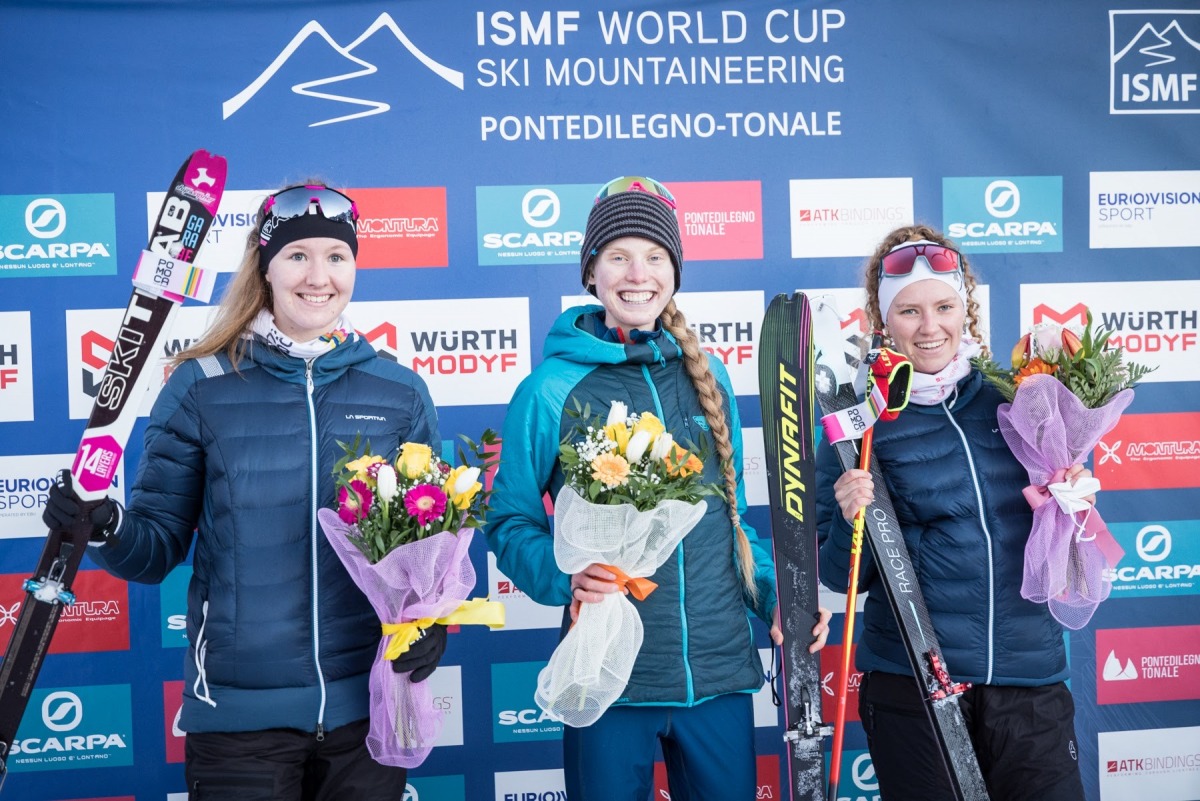
Grace Staberg, center, placed first in the U20 Vertical race at the season’s first ISMF World Cup. Photo: Maurizio Torri
As for my races, it appears that my fall “training camp” in Tignes was largely successful in helping me get in shape for the early season competitions. I left Ponte di Legno proud of my results in the Vertical (1st) and Individual (2nd) races, but with plenty of improvements and things to work on in mind. I’m heading to Chamonix to spend the holidays with my family before gearing up for the second World Cup of the season in Comapedrosa, Andorra.
Grace Staberg grew up in Silverthorne, Colorado and races both domestically and internationally as a trail runner and skimo athlete. She races the ISMF Skimo World Cup circuit in the winter, and when not racing, can be found on long adventures in the mountains. She is the North American Record Holder for most vertical feet ascended in 24-hours and enjoys nothing more than a good sufferfest. Alongside athletic goals, she is studying Economics and Finance at the London School of Economics. Grace is also passionate about mental health advocacy, mentorship of young athletes in sport and helping others to find as much joy and gratitude in the mountains as she does.

